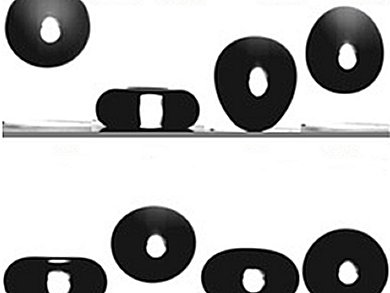A major goal in coating research is to design self-cleaning surfaces. Coatings that are simultaneously superhydrophobic and superoleophobic are rare.
Doris Vollmer, Max Planck Institute for Polymer Research, Mainz, Germany, and colleagues designed an easily fabricated, transparent, and oilrebounding superamphiphobic coating. A porous deposit of candle soot was coated with a 25 nm thick fluorinates silicon shell. The black coating became transparent after calcination at 600°C. After silanization the coating is superamphiphobic and remained so even after its top layer was damaged by sand impingement.
The structure of the coating resembles a sponge-like labyrinth of completely unordered pores, which is made up of tiny spheres. Liquids that wet even fluorinated surfaces would have to be pressed over these spheres, which requires too much energy. A drop of the liquid first bounces up off the surface before coming to rest on it as an almost perfect sphere (pictured).
The transparent coating that is very good at repelling water and oil could not only keep water and dirt away from the lenses in glasses and car windscreens, but also, for example, from the glass facades of skyscrapers. It could also prevent residues of blood or contaminated liquids on medical equipment.
- Candle Soot as a Template for a Transparent Robust Superamphiphobic Coating,
Xu Deng, Lena Mammen, Hans-Jürgen Butt, Doris Vollmer,
Science 2011.
DOI:10.1126/science.1207115




